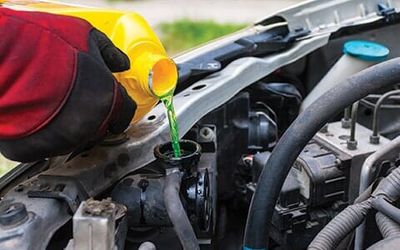COOLANT EXCHANGE
COOLING SYSTEM SERVICE
WHAT IS A COOLING SYSTEM?
A typical 4 cylinder vehicle cruising along the highway at around 50 miles per hour, will produce 4000 controlled explosions per minute inside the engine as the spark plugs ignite the fuel in each cylinder to propel the vehicle down the road. Obviously, these explosions produce an enormous amount of heat and, if not controlled, will destroy an engine in a matter of minutes. Controlling these high temperatures is the job of the cooling system.
The modern cooling system has not changed much from the cooling systems in the model T back in the '20s. Oh sure, it has become infinitely more reliable and efficient at doing it's job, but the basic cooling system still consists of liquid coolant being circulated through the engine, then out to the radiator to be cooled by the air stream coming through the front grill of the vehicle.
The modern cooling system has not changed much from the cooling systems in the model T back in the '20s. Oh sure, it has become infinitely more reliable and efficient at doing it's job, but the basic cooling system still consists of liquid coolant being circulated through the engine, then out to the radiator to be cooled by the air stream coming through the front grill of the vehicle.

Today's cooling system must maintain the engine at a constant temperature whether the outside air temperature is 110 degrees Fahrenheit or 10 below zero. If the engine temperature is too low, fuel economy will suffer and emissions will rise. If the temperature is allowed to get too hot for too long, the engine will self destruct.
COOLING SYSTEM SERVICE
WHAT IS A COOLING SYSTEM?
A typical 4 cylinder vehicle cruising along the highway at around 50 miles per hour, will produce 4000 controlled explosions per minute inside the engine as the spark plugs ignite the fuel in each cylinder to propel the vehicle down the road. Obviously, these explosions produce an enormous amount of heat and, if not controlled, will destroy an engine in a matter of minutes. Controlling these high temperatures is the job of the cooling system.

The modern cooling system has not changed much from the cooling systems in the model T back in the '20s. Oh sure, it has become infinitely more reliable and efficient at doing it's job, but the basic cooling system still consists of liquid coolant being circulated through the engine, then out to the radiator to be cooled by the air stream coming through the front grill of the vehicle.
Today's cooling system must maintain the engine at a constant temperature whether the outside air temperature is 110 degrees Fahrenheit or 10 below zero. If the engine temperature is too low, fuel economy will suffer and emissions will rise. If the temperature is allowed to get too hot for too long, the engine will self destruct.
COOLING SYSTEM MAINTENANCE
An engine that is overheating will quickly self destruct, so proper maintenance of the cooling system is very important to the life of the engine and the trouble free operation of the cooling system in general.
The most important maintenance item is to flush and refill the coolant periodically. The reason for this important service is that anti-freeze has a number of additives that are designed to prevent corrosion in the cooling system. This corrosion tends to accelerate when several different types of metal interact with each other. The corrosion causes scale that eventually builds up and begins to clog the thin flat tubes in the radiator and heater core, causing the engine to eventually overheat. The anti-corrosion chemicals in the antifreeze prevents this, but they have a limited life span. The basic rule for when to flush the coolant is every two years or 30,000 miles for non-extended life antifreeze and every five years or 100,000 miles for extended life antifreeze.
The most important maintenance item is to flush and refill the coolant periodically. The reason for this important service is that anti-freeze has a number of additives that are designed to prevent corrosion in the cooling system. This corrosion tends to accelerate when several different types of metal interact with each other. The corrosion causes scale that eventually builds up and begins to clog the thin flat tubes in the radiator and heater core, causing the engine to eventually overheat. The anti-corrosion chemicals in the antifreeze prevents this, but they have a limited life span. The basic rule for when to flush the coolant is every two years or 30,000 miles for non-extended life antifreeze and every five years or 100,000 miles for extended life antifreeze.
BROWSE OUR WEBSITE
HOURS OF OPERATION
| Mon-Fri | 8:00 AM - 5:00 PM |
| Sat-Sun | Closed |
HOURS OF OPERATION
| Mon-Fri | 8:00 AM - 5:00 PM |
| Sat-Sun | Closed |
HOURS OF OPERATION
| Mon-Fri | 8:00 AM - 5:00 PM |
| Sat-Sun | Closed |
Content, including images, displayed on this website is protected by copyright laws. Downloading, republication, retransmission or reproduction of content on this website is strictly prohibited. Terms of Use
| Privacy Policy






